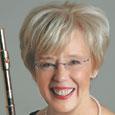.jpg) Carol Wincenc and I sat down to chat in Oberlin, Ohio on a cold winter day in 2009. We talked about her life and the upcoming concert season, which is a special one for her. She is celebrating her 40th anniversary of performing by playing a four-event celebration that spans the 2009-2010 concert season. The first event took place at the National Flute Association convention in New York City, where she and pianist Stephen Gosling played the world premiere of Jonathan Berger’s Calcine Crown, Andrew Thomas’s Samba, and a two-flute arrangement of Dinicu’s Hora Staccato, which she performed with eight-year-old flutist Emma Resmini.
Carol Wincenc and I sat down to chat in Oberlin, Ohio on a cold winter day in 2009. We talked about her life and the upcoming concert season, which is a special one for her. She is celebrating her 40th anniversary of performing by playing a four-event celebration that spans the 2009-2010 concert season. The first event took place at the National Flute Association convention in New York City, where she and pianist Stephen Gosling played the world premiere of Jonathan Berger’s Calcine Crown, Andrew Thomas’s Samba, and a two-flute arrangement of Dinicu’s Hora Staccato, which she performed with eight-year-old flutist Emma Resmini.
Wincenc grew up in the suburbs of Buffalo in Williamsville, New York. “It’s a very upscale, white-collar community with a fantastic public school system. I had studied the violin with my dad from the age of four, and subsequently chose the flute so that I could play in the band.” Her father was the first concertmaster of the Buffalo Philharmonic Orchestra when it was in its infancy as a W.P.A. orchestra. He went on to be the orchestra’s associate conductor and also started several community orchestras in the area.
Her parents fostered her interest in music. “My mother worked with me on piano. I remember making up songs that she orchestrated for me. My very first song was:
Here come the ponies down the street.
Galloping, galloping hear their feet.
Shining manes are flying high.
Will they touch the blue, blue sky?
Pony can I ride?
“I heard chamber music at home constantly. Musicians often came to the house, and my mother also taught piano students. Hearing all of that music, and watching my parents was wonderful. My dad was such a mentor – by my side all the time with the fiddle, making sure that each bowing was just right. At nine I switched to flute, which I thought was very feminine and pretty.”
Her first flute teacher was her band director, Vincent Morette. “When my parents saw that I had an aptitude for flute, they found a private teacher for me, and I started working with a former Moyse student, Edna Comerchero. We worked on De la sonorité from day one to find a singing tone quality. After a year I moved on to Robert Mols, who had studied with Mariano at Eastman.” In high school she studied with Anton Wolf, who was a flutist in one of her father’s community orchestras.”
A Year in Italy
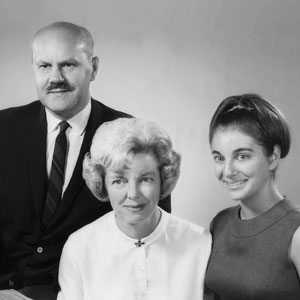 While Wincenc was in high school, her father was invited to be an exchange professor for a year in Siena, Italy. “It was 1966, and I graduated from high school a year early so I could go along. It was pretty remarkable because the summer before we left for Italy, Karl Kraber came to Buffalo to play in the Dorian Quintet. Karl is about as charismatic as you can get, and he just turned my head around. I worked on chamber music with him, and my parents got to know him as well. When they asked him what they should do with me in Italy, he replied, ‘There’s no question. She should go to Rome and study with Gazzelloni.’
While Wincenc was in high school, her father was invited to be an exchange professor for a year in Siena, Italy. “It was 1966, and I graduated from high school a year early so I could go along. It was pretty remarkable because the summer before we left for Italy, Karl Kraber came to Buffalo to play in the Dorian Quintet. Karl is about as charismatic as you can get, and he just turned my head around. I worked on chamber music with him, and my parents got to know him as well. When they asked him what they should do with me in Italy, he replied, ‘There’s no question. She should go to Rome and study with Gazzelloni.’
“On the ship over to Europe we had many discussions about where I would live. My parents were going to be in Siena, but I would be in Rome. Once again good fortune struck. We met a group of young women from the Rhode Island School of Design who were on their way to study in Rome for a semester. They would be living in a lovely boarding house run by a nice woman who just happened to have an extra room. When she heard that I was a musician, she asked me to sing for her. She was the accompanist for the Coro Academia Filharmonica Romana (Philharmonic Chorus) and liked my singing enough to get me into the group. We toured and sang with the Radio Orchestra of Rome; in fact, I sang professionally with that chorus as much as I studied the flute that year. It was a phenomenal experience. What a way to learn the language, just being thrown into this chorus. I was
just 17.”
When she played for Gazzelloni, he agreed to take her as a student. “It was wonderful. The only other American flutist he knew about was Paula Robison, who had just won the Geneva Competition. She became this figure that I emulated for years.”
When the family returned to the U.S., Wincenc went to the Oberlin Conservatory for college, but only stayed two years. “My family has an Oberlin legacy. Both my parents were students there in the 1930s, and my father was president of his class for three years. I think after that wild year in Rome, my mother wanted to have the comfort of knowing that I would be in a dormitory. Oberlin was very different from Italy where I was mostly on my own.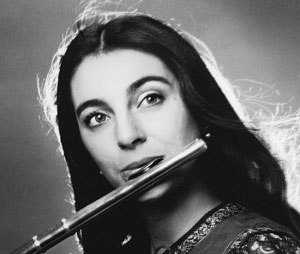
“Willoughby assigned lots of etudes, long tones, and articulation exercises but not much repertoire. Intonation was a huge issue for him. It is so imperative that flute players learn to play in tune. He was very methodical and extremely demanding, but I was like a stallion at the gate after my year in Italy!
“We worked on the Hindemith Sonata, the Schubert variations, and some of the French Conservatory pieces. Outside of those, however, I studied mainly new music. I remember being asked to play Afternoon of a Faun during an orchestra audition there, and I had never played it before. I knew what it was, but can you imagine not knowing it? Today’s students all know that famous solo.
“This all took place during the Vietnam war years, and the campus was a very politically active place. A group of us decided to transfer and were accepted to Juilliard – only to discover that they subsequently decided they could not accommodate us because of their move to Lincoln Center. Everything fell apart for me at that point. My Dad knew Steve Maxym, a bassoonist on the faculty at Manhattan, and Steve suggested that I audition at Manahattan.”
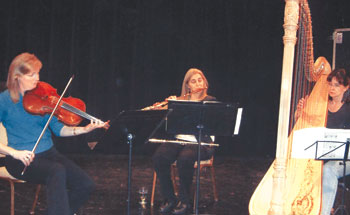
She was accepted and earned a bachelor’s degree at Manhattan studying with Harold Bennett. “He was such a character. In the summers I worked with James Pellerite at the Chautauqua Institute. I was so lucky to have this wealth of really solid teachers. After graduation from Manhattan in 1971, I worked with Albert Tipton at Aspen for three summers, where I was principal flute of the Chamber Symphony.”
Over the years she worked with Sam Baron, Arthur Lora, and Charles Delaney. “I also took lessons with Marcel Moyse in Brattleboro, Vermont. He was not coaching at the Marlboro Festival then, but I saw him independently. I’d drive from New York City and go cross-country skiing while I was there. When I got to Moyse, it felt like coming home. He was always singing and referred to the voice and the singing style in his teaching – an approach that I had also learned from my parents and Edna Comerchero. My father had a beautiful legato, singing style when he played the violin.”
While in school she had considered a permanent orchestral career. “Juilliard was sort of geared toward orchestral careers, and in my class were Renee Seibert, Trudy Hartmann, Michael Parloff, Trudy Kane, Nadine Asin, and Ransom Wilson. The job that I got out of college was the St. Paul Chamber Orchestra. There was only one flute; it was really solo playing.”
The St. Paul Chamber Orchestra
In 1972 Wincenc was hired to play in the St. Paul Chamber Orchestra by conductor Dennis Russell Davies, a position she would remain in for five years. Shortly after she arrived, Jean-Pierre Rampal came to play with the orchestra. “I was designated to pick him up. Out of the airport came this gigantic man in a mink coat whom I revered. He couldn’t have been more wonderful, and he came every season that I was there.
“The orchestra had a five-state outreach program, and I know those states thoroughly. I vividly remember playing in Brookings, South Dakota because it was the first time I ever ate buffalo meat. We also hit Fargo, North Dakota, Eau Claire, Wisconsin, Moorhead, Minnesota, and Madison, Wisconsin, which was the only place I found with a 24-hour deli during my entire five years with the orchestra.
“The orchestra owned its own plane, a DC3, that sat 28 people. We landed in Bismark, North Dakota in the middle of a blizzard and tromped through the airport. The concertmaster looked very Mediterranean, complete with a suntan and fur coat, and Dennis Russel Davies was wearing his motorcycle jacket and a ponytail. We walked by a group of men in cowboy boots while heading toward the baggage claim area, and I heard one of the men say, ‘They look like a bunch of foreign exchange students to me.’
New York City
.jpg) From St. Paul, Wincenc returned to New York, and in 1979 she made her New York debut at Alice Tully Hall as a Naumberg Winner. That year also saw the release of her first recording, Music of George Rochberg, which was released by CRI on cassette. Over the next few years she made several C.D.s with the Musical Heritage Society, Warner Brothers, and MusicMasters. “By 1989 I was well on my way with a full blown career and representation with IMG Artists.” She was also on three conservatory faculties simultaneously, Indiana University, Rice, and Juilliard. Today her recordings total more than 20. The most recent is Samuel Adler, Of Musique, Poetrie, Art, and Love (Naxos).
From St. Paul, Wincenc returned to New York, and in 1979 she made her New York debut at Alice Tully Hall as a Naumberg Winner. That year also saw the release of her first recording, Music of George Rochberg, which was released by CRI on cassette. Over the next few years she made several C.D.s with the Musical Heritage Society, Warner Brothers, and MusicMasters. “By 1989 I was well on my way with a full blown career and representation with IMG Artists.” She was also on three conservatory faculties simultaneously, Indiana University, Rice, and Juilliard. Today her recordings total more than 20. The most recent is Samuel Adler, Of Musique, Poetrie, Art, and Love (Naxos).
The commissions began in 1978. Wincenc has over 14 compositions commissioned by or for her. They include such composers as George Rochberg, Ezra Laderman, David Del Tredici, Daniel Paget, Joan Tower, Joseph Schwantner, Robert Beaser, Samuel Adler, Robert Capanna, and Paul Schoenfield, to name just a few. That is an enormous contribution to the flute community worth celebrating.
She commented, “It is a wonderful experience to work with composers. Lukas Foss was my first commission. He could play all of his works at the piano. For example, in The Renais-sance Concerto he boasted that ‘the right notes are Rameau’s and the wrong notes are mine.’ Christopher Rouse always said, ‘You sound great.’ He was sort of minimal. Some composers’s writings are demanding and some are not. Schoenfeld and Peter Schickele were very demanding. Some of Joan Tower’s passages were almost unplayable.”
Teaching
Wincenc has been teaching at Juilliard for 23 years, and at Stony-Brook for 12. She does all her teaching at Stony-Brook on one day with two hours to get there, six hours of teaching, and two hours to drive back home.
“Growing up with string players and participating in various choral activities, I had a very mixed background. The Tipton, Delaney, Pellerite, and Baker influence gave me the American flute tradition, so I had French training with an American mix – French tone production and articulation with the robustness of American style. Those influences have shaped the way I teach and play.
“I insist that the students play #1, #4, and #5 from Taffanel and Gaubert every day. If I don’t play scales, I feel incomplete. I do a whole breathing exercise routine as well. When I was in my early twenties, my breathing was constricted, but I met Alexander Murray in England and started doing Alexander technique, breathing through my nose and giving myself permission to breath.
“As to repertoire, I’m a real fan of Boehm, Altès, and Andersen etudes. A lot of my work as a teacher is finding out where a student is in their development. Then we work on what they need the most.”
“Music was always my dominant interest, but my mother started me dancing and moving to music at an early age. I started dancing lessons at age seven and continued until I was 14. I also studied drama through high school and it helped my inner projection as a performer.
“I think getting into character when playing music is just as important as when you are acting. When I work on orchestral excerpts with my students, it’s much like being a drama student. That’s what I love about orchestra excerpts; they use dramatic skills. You have to get into character immediately with the exact tempo and with a plan for precise breathing and expression. Orchestral solos are similar to 20-second monologues. Some of our richest moments come in the symphony orchestra.
“In solo repertoire you have the opportunity to expand that character a little bit longer because you are in a piece or movement. I was so keen on the Moyse 24 Melodies with variations that I had all of my students write poems for each one. That helped them get into the character.
“The arts are all inter-related. That’s one of the things I love about Juilliard. We have a course called Colloquium. Everyone in the Freshman class collaborates in small groups of students from various disciplines. They create a presentation that grows out of the group’s ideas and strengths.
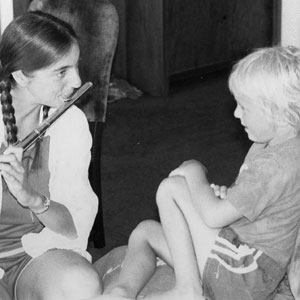
Staying In Shape
“I spend most of my time on technical exercises, such as Taffanel-Gaubert #5 as a breathing exercise and #1. I practice #4 all legato and staccato and then play a series of orchestral excerpts: La Volière, Scherzo from A Midsummer Nights Dream, and Bach’s Badinerie from the B-minor Suite. I just don’t have time for etudes. I am also a big believer of practicing backwards. Playing nasty spots backwards builds confidence.”
A recent accident has changed how she practices. “A year ago this Christmas my son and I went to Italy and were hit head-on by another car. Among other serious injuries I had four vertebral fractures and a broken right hand. My son Nikky was okay, but I was in Italy for a month. When I got back I found that my hand had not been dealt with properly. That required a second operation, and kept me from playing for 4½ months. I played my first concert after that the beginning of April. Fortunately it was my right hand thumb that broke.
“I now have to take time to warm up. I also swim, and have started doing yoga. I didn’t used to do Taffanel-Gaubert #1, but now I practice it religiously, and I have a whole series of head, neck, and arm exercises as well.
“I always practice in combination with the breath. I have found over the years that a lot of issues emanate from inhalations and exhalations that are not thorough enough. That concept came from Murray. I call it healthy completion and healthy depletion, so the breath is not a panic depletion. By breathing through the nose I can inflate fully and give myself the permission to do so. Permission is such an important word for wind players. Great opera singers don’t think twice about permitting themselves to breathe.”
During our conversation about her flute lineage, Wincenc referred to herself as a mutt, because she was influenced by a combination of the French and American flute schools. I would venture to add that she represents the best of all possible musical worlds–through the mixture of string/woodwind musical background, the amalgamation of her pedagogical and soloistic careers, and through her commission projects, which have provided a great service to the flute community.
The Ruby Anniversary Celebration
“I came to New York City in 1969 – 40 years ago – thus the Ruby Anniversary Celebration. I will play a second concert at the Merkin Concert Hall on November 9 with San Francisco-based composer and pianist, Jake Heggie, who wrote a new flute and piano work, Fury of Light, for me. The program also features Lukas Foss’s Three American Pieces arranged for flute and piano, Paul Schoenfield’s Six Chassidic Songs, and George Crumb’s famous 1971 work Voice of the Whale for electric flute, electric piano, and electric cello.”
The next concert takes place at The Morgan Library & Museum on February 22, 2010, and features Wincenc’s flute, viola, harp trio Les Amies. They will perform Thea Musgrave’s Sunrise, for flute, viola, and harp, and Andrea Clearfield’s …and low to the lake falls home… A Memoriam to Joseph and Margaret Wincenc, for flute, viola, and harp. The program also features Bach’s Sonata in E-flat Major, BWV 1031, arranged for flute and harp; Arnold Bax’s Elegiac Trio; Ravel’s Sonatine arranged for flute, viola, and harp; Devienne’s Duo in C minor, Op. 5, No. 3, for flute and viola; and Debussy’s Sonata for flute, viola, and harp.
On March 31, 2010, Wincenc performs at Peter J. Sharp Auditorium at The Juilliard School. The program includes the premier of a new work for flute and string quartet by Joan Tower, a new chamber concerto for flute soloist, oboe, clarinet, percussion, piano, violin, cello, and bass by Shih Hui Chen’s. Vivaldi’s Flute Concerto in D Major, “Il Gardellino,” will begin the program, which will conclude with dozens of her current and former students from Stony Brook University and the Juilliard School joining in a performance of Andrew Thomas’s Samba. Both Shih Hui Chen and Joan Tower will attend the concert. For more information go to http://www.myspace.com/cwincenc

